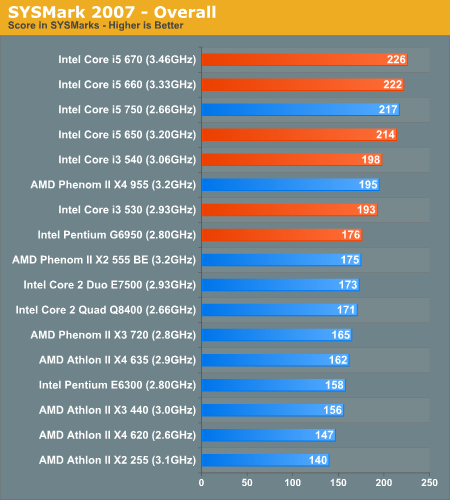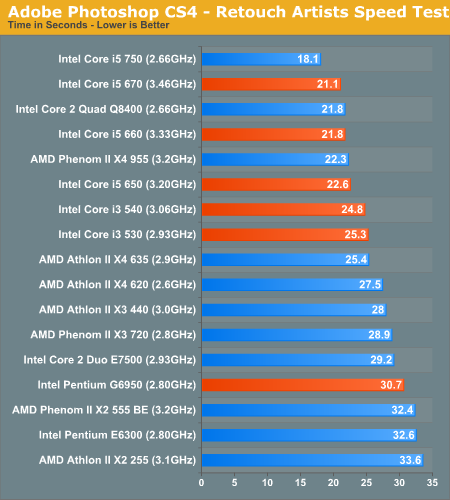The Rest of Clarkdale: Intel's Pentium G6950 & Core i5 650/660/670 Reviewed
by Anand Lal Shimpi on March 24, 2010 4:00 PM EST- Posted in
- CPUs
SYSMark 2007 Performance
Our journey starts with SYSMark 2007, the only all-encompassing performance suite in our review today. The idea here is simple: one benchmark to indicate the overall performance of your machine.

SYSMark ends up being a fairly lightly threaded test, optimized mostly for dual core processors. As such, the Athlon II X3 doesn't really get much benefit from that third core and ends up being more of a Penryn competitor than in the same class as the Core i5/i3 and Pentium G6950.
As a business desktop machine, the Pentium G6950 is a competant option. Clearly slower than the Core i3 530 but not much else. The faster dual core i5s do well here.
Adobe Photoshop CS4 Performance
To measure performance under Photoshop CS4 we turn to the Retouch Artists’ Speed Test. The test does basic photo editing; there are a couple of color space conversions, many layer creations, color curve adjustment, image and canvas size adjustment, unsharp mask, and finally a gaussian blur performed on the entire image.
The whole process is timed and thanks to the use of Intel's X25-M SSD as our test bed hard drive, performance is far more predictable than back when we used to test on mechanical disks.
Time is reported in seconds and the lower numbers mean better performance. The test is multithreaded and can hit all four cores in a quad-core machine.

For a photoshop workstation, Intel's quad-core i5 can't be beat by anything in the i5 lineup - even if you spend more than $200. The Pentium G6950 doesn't do so well here. While it's faster than the Pentium E6300, it's slower than the Core 2 Duo E7500 and AMD's Athlon II X3 440. Photoshop likes to spawn CPU intensive threads and thus Hyper Threading actually matters here. You'll want at least an i5 if you're building a good Photoshop box.










70 Comments
View All Comments
geok1ng - Wednesday, March 24, 2010 - link
and once again i request side-by-side screenshot comparison of these integrated graphics, to remove any reasonable doubt that Intel is not cheating (again ) on image quality to push FPS higher.vol7ron - Wednesday, March 24, 2010 - link
I know there's been debate in the past about i3 vs i5, but would i5 be a better buy if you can't overclock? Say for instance you get a laptop that has a locked bios. Even though the i5 is more expensive, wouldn't it still be a better performer in all things not batter/Intel HD?KaarlisK - Wednesday, March 24, 2010 - link
If I really care about performance, I'm buying a quad core. The Athlon II X4 is cheap anyway - so I really can't imagine a situation where I'd take an Athlon II X3. It's basically either a cheap(ish) dualcore or a good quadcore for me.Also, it's possible to see that the i3 530 REALLY is a lower bin - it has much higher power consumption at load than any other bin. So it would be interesting to compare how an i3 530, 540 and an i5-6xx overclock, and how their power consumption curve looks (with the same multiplier&fsb of course).
qwertymac93 - Wednesday, March 24, 2010 - link
will someone please explain how a crippled, handicaped, bastard child of a cpu that is the g6950 can score higher in sysmark 2007 then a high end, QUAD CORE cpu(pII 955) that has more features, bigger cache, higher clockspeed, and twice as many cores. I mean, all of clarkdale's advantages have been taken out and it STILL outscores everything. no turbo, no hyperthreading, lower clockspeed in the core, uncore, AND memory, and no virtualization! That's it, sysmark will forever be ignored in my mind as its clearly biased somehow. this is not because it outscored an amd cpu, its because it outscored ALL the other cpus on the chart, core2, core2quad, aII, pII, everything!Jamahl - Wednesday, March 24, 2010 - link
You are right, sysmark is a joke of a benchmark and the sooner AT gets rid of it the better for everyone.qwertymac93 - Wednesday, March 24, 2010 - link
correction, it doesn't outscore the 955, but its damn close...Anand Lal Shimpi - Wednesday, March 24, 2010 - link
SYSMark is definitely showing its age, but lots of corporations rely on its data to make purchasing decisions. SYSMark doesn't scale very well beyond 2 cores, which is why the Phenom II X4 doesn't get much credit for its extra 2 cores.Keep in mind that clock for clock the Phenom II is slower than Core 2 and Nehalem/Westmere (http://www.anandtech.com/cpuchipsets/showdoc.aspx?...">http://www.anandtech.com/cpuchipsets/showdoc.aspx?....
An ultra low latency L2 plus a pair of high IPC cores (HT doesn't matter as much in a benchmark that mostly uses 2 cores) mean that even the G6950 does well here.
AMD does a lot better in the other tests because most of our other benchmarks do show more of an advantage from more than 2 cores among other things.
The benchmark is getting old, but it is a good representation of a lighter workload by today's standards. For heavier threaded workloads we offer everything from the x264 test to the par2 data recovery test.
We never recommend relying on just a single benchmark but rather letting each one tell their piece of the story and then making a decision based on the benchmarks that represent your workloads.
Take care,
Anand
KaarlisK - Wednesday, March 24, 2010 - link
It does show one thing. The value of G6950 & Core i3.For my school, where I'm buying computers for the teachers' desktops, the G6950 is more than adequate - and in most productivity tasks (browsing + word/powerpoint) it won't be much slower. The benchmarks also show that if I need a bit more power for this combination - mostly lightly threaded, some photoshop/video - I can safely choose a dual-core,four-thread Core i3/i5, instead of going for a quadcore i5 that requires external graphics and consumes more power.
And I'm not touching AMD builds with a bargepole. They don't have AHCI for my cheap SSD's, they are usually slower booting and in other similar everyday tasks (as shown by laptop reviews on Anandtech), and they consume more power, while the new Intel graphics core has removed my reservations about G45.
And I do have an AMD build at home as a cheap gaming/rendering computer, as it's the best way to obtain that specific goal - but there, I don't have to worry about keeping everything shipshape.
qwertymac93 - Wednesday, March 24, 2010 - link
im pretty sure amd cpus support ahci(which has more to do with the chipset really...), either that or both my bios, my ears, and windows are all lying to me. when i enable AHCI in my bios(foxconn a7gm-s) windows shows my two sata drives as removable scsi drives, weird but whatever.KaarlisK - Thursday, March 25, 2010 - link
But AHCI with AMD chipsets is broken (or maybe the driver is) and SATA performance is lower.Of course, it is cheaper to get AMD's sometimes-broken AHCI (usually, it works with Microsoft's driver, but not with AMD's driver, and the performance is lower) than to get Intel's working AHCI (G41 boards don't have it, even the cheapest AMD boards do); on the other hand, sometimes I just CANNOT install Win7 on boards with AMD's AHCI and specific hard drives.